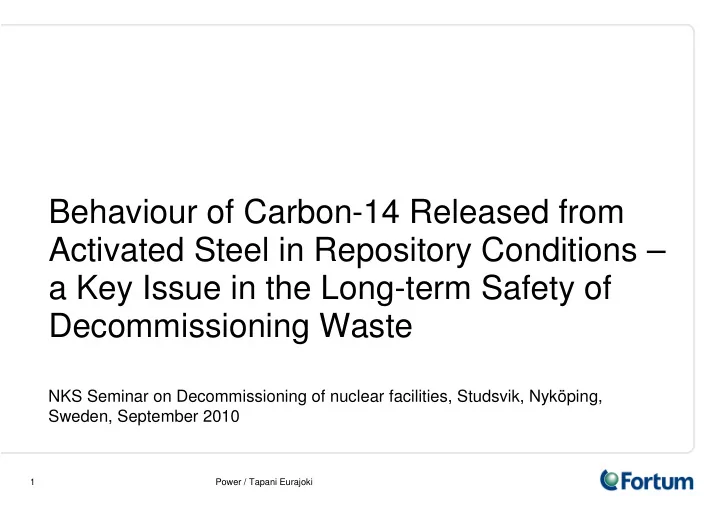

Behaviour of Carbon-14 Released from Activated Steel in Repository Conditions – a Key Issue in the Long-term Safety of Decommissioning Waste NKS Seminar on Decommissioning of nuclear facilities, Studsvik, Nyköping, Sweden, September 2010 1 Power / Tapani Eurajoki
Contents of the presentation • origin and activity of C-14 in activated metal components • final disposal of activated components in Loviisa NPP • corrosion as the release mechanism • chemical speciation of the released carbon • some comments on the conducted experimental work • approach chosen for the safety assessment of Loviisa NPP decommissioning plan • possible mechanisms to affect the speciation • ideas for further experimental work - and related problems 2 Power / Tapani Eurajoki
Origin and activity of C-14 in activated metal components • Neutron activation, three reactions: – N-14 (n,p) C-14 – C-13 (n,g) C-14 Induced activity in the decommissioning waste – O-17 (n,a) C-14 1E+9 • In an LWR, in stainless 1E+8 steel the reaction from 1E+7 activity, GBq N-14 dominates 1E+6 1E+5 1E+4 1E+3 Induced activity in the 1E+2 decommissioning waste of the 1 10 100 1000 10000 100000 1000000 time, yrs Loviisa NPP TOTAL C-14 Ca-45 Mn-54 Fe-55 Co-60 Ni-59 Ni-63 Eu-152 H-3 3 Power / Tapani Eurajoki
Final disposal of activated components; case: Loviisa NPP, reactor pressure vessel with internals • One-piece removal of large components • Reactor internals are packed in the RPV • The nozzles are sealed. • Surrounding concrete silo structure • Low corrosion rate 4 Power / Tapani Eurajoki
Release from steel and chemical speciation of carbon • Carbon is assumed to be released from steel, as the steel corrodes. • In anaerobic conditions in cementitious environment the corrosion rate is low (~0.1 µm/a). • Diffusion from steel is believed to be low compared to corrosion. • Chemical speciation in the activated steel (carbide?; what happens if C- 14 is formed from N-14 as nitride? High neutron energy involved.) • Chemical speciation after being released from the activated steel? – carbonate? => low solubility and large amount stable carbonate in the cementitious repository conditions => OK – soluble organic form? => possibly very mobile – gaseous organic form? => solubility, mobility • According to Pourbaix diagram the organic forms should not be stable in the alkaline and reducing repository conditions; still there are indications of their existence. 5 Power / Tapani Eurajoki
Possible migration routes for C-14 from the repository to the biosphere C-14 ORGANIC INORGANIC GAS LIQUID DISSOLVED RETAINED IN CARBONATE CARBONATE - NEGLIGIBLE FORM DISSOLVED TRANSPORTATION GAS IN GAS PHASE RETAINED IN ATMOSPHERIC METABOLISM - ATMOSPHERIC ATMOSPHERIC WELL WELL REPOSITORY RELEASE PLANT UPTAKE RELEASE RELEASE 6 Power / Tapani Eurajoki
Some comments on the available literature and the conducted experimental work • Only few relevant articles on experimental results are available. • Experimental works by Deng et al. (1997) and Kaneko et al. (2003) are often cited – open questions regarding coverage, representativeness and relevance for the repository issue • phenomenology to some extent unclear • redox conditions may not be representative • Both gaseous and soluble organic compounds were detected • No straightforward quantitative conclusions can be drawn. • A master’s thesis (Kuitunen 2007) was financed by Fortum for the safety assessment of Loviisa NPP – Literature survey – …even though the formation of organic species has not been confirmed, their existence cannot be denied and this should be taken into account in the future safety assessments. • Research is going on… 7 Power / Tapani Eurajoki
Approach chosen for the safety assessment of Loviisa NPP decommissioning plan • Release from the metal according to the corrosion rate • Soluble and mobile chemical form assumed • Sensitivity analysis: gaseous chemical form • => C-14 is the dominant nuclide 1.0E+11 1.0E+10 Release rate (Bq/a) 1.0E+09 1.0E+08 C-14 1.0E+07 Ni-59 Tc-99 1.0E+06 Nb-94 1.0E+05 1.0E+04 Release rates as 1000 years’ 1.0E+03 averages compared to regulatory 1.0E+03 1.0E+04 1.0E+05 1.0E+06 constraints (dashed lines) Time (a) 8 Power / Tapani Eurajoki
Possible phenomena/mechanisms to tackle the problem • chemical reactions between organic forms and carbonate; kinetics? • some catalysts to enhance the reactions • isotopic exchange • radiolysis to decompose the organic molecules • microorganisms • … • behavior of the organic species: sorption, diffusion? • => Need for further experimental work 9 Power / Tapani Eurajoki
Questions and ideas for further experimental work - and related problems • A long phenomenological chain from the steel to the biosphere; which phenomena are to be investigated? • Is C-14 chemically similar to C-12 in steel => research work with radioactive substances. • Accelerated corrosion is probably needed in the experiments, but how not to disturb the speciation of carbon? • The reported experiments should be repeated with additional measurements. • All the chemical species should be measured. • If assumed to be organic => possible reactions and their kinetics (possible to experiment with inactive substances). • Long timescales characterize the repository conditions => how to accelerate the experiments. • Research within NKS? 10 Power / Tapani Eurajoki
Conclusions • C-14 in activated steel components may be one of the major dose contributors in the decommissioning waste. • Chemical speciation of C-14 in repository conditions is not completely clear. • Organic species may be significantly more mobile than inorganic ones. • The problem is characterized by a long phenomenological chain from the steel to the biosphere. • Further research is necessary to reveal the main chemical reactions and their kinetics. • A more detailed – and possible less conservative – modelling can be applied only if the phenomenology is sufficiently well known. 11 Power / Tapani Eurajoki
Thank you for your attention! 12 Power / Tapani Eurajoki
Recommend
More recommend